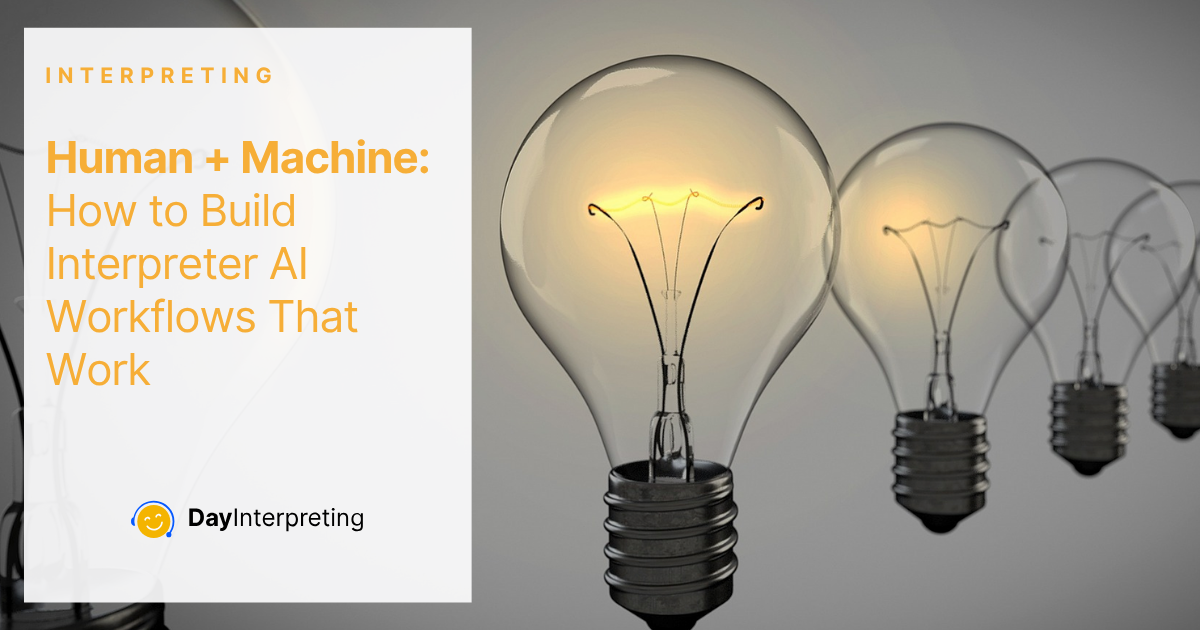An AI interpreter workflow refers to the integration of artificial intelligence tools into the process of interpreting, whether for live events, virtual meetings, or recorded content. These workflows help streamline the phases of interpretation, including before, during, and after. To be clear, AI isn’t here to replace human interpreters; it’s here to enhance their capabilities. So, that being said, what’s the big hype, and how should you go about building interpreter AI workflows?
The short answer is this: Well-designed interpreter AI workflows are used like a co-pilot: assisting with preparation, offering support during the session, and helping analyze outcomes, all while the human interpreter leads the way.
Why Build Interpreter AI Workflows?
As global communication increases, so does the demand for interpreting services that are fast, accurate, and scalable. Interpreters work across multiple sectors, from healthcare and law to business and government, and often operate under intense time pressure.
Interpreter AI workflows can help by:
- Reducing manual prep time
- Improving accuracy and consistency
- Automating repetitive or administrative tasks
- Scaling language access to meet client needs
The key is not automation for automation’s sake, but purposeful integration that supports the interpreter’s role.
Step-by-Step: Building an Interpreter AI Workflow
Step 1: Pre-Session Preparation
AI tools can make preparation more innovative and more efficient. Interpreters can use AI to:
Generate Glossaries Automatically
Software such as Trados, MemoQ, and Termbase can analyze background documents and generate tailored glossaries based on domain-specific vocabulary.
Summarize Background Material
AI-powered summarizers, such as Notion AI or ChatGPT, can quickly provide overviews of technical documents, briefs, or meeting agendas, helping interpreters grasp the big picture before the session.
Flag High-Risk Terms
Advanced tools can also scan documents for idiomatic expressions, ambiguous terms, or culturally sensitive content that may need extra attention during live interpreting.
Step 2: Real-Time Assistance
AI can assist interpreters during live interpreting sessions in various ways. Here’s a look at some smart, practical applications:
Automatic Speech Recognition (ASR)
Live transcription tools, such as Otter.ai or Zoom’s built-in transcription, can help interpreters follow speakers more accurately, especially in cases of poor audio or unfamiliar accents.
AI-Generated Reference Translations
Platforms like Interprefy and KUDO are experimenting with live AI-generated translations. While these are not suitable for replacing human output, they can provide helpful real-time suggestions or a secondary reference stream.
Intelligent Note-Taking
AI tools can record and segment information by topic, timestamp key statements, and even differentiate between speakers. These notes can support consecutive interpreting or be used for review between segments.
Step 3: Post-Session Follow-Up
AI can also be used to wrap up sessions more efficiently. Here’s how:
Generate Summaries and Transcripts
AI can instantly create multilingual summaries, transcripts, or reports based on the interpreted session, adding value for clients and improving workflow documentation.
Performance Review and Quality Checks
Some training tools now offer performance analysis using AI, tracking speaking speed, vocabulary diversity, filler word usage, and tone modulation. This can help interpreters reflect on and improve their performance.
Build a Personalized Knowledge Base
By feeding past interpreting data into AI tools, interpreters can develop custom insights into their work patterns, vocabulary usage, and client-specific language preferences.
Tips for Building Effective Workflows
- Start with preparation tools before moving into live assistance or post-session automation
- Train your AI tools by feeding them industry-specific content and terminology
- Keep complete control of output and use AI suggestions as a complement, not a replacement
- Use ethical tools that prioritise data security and confidentiality
- Continuously adapt as new AI tools and features emerge across the language industry
Final Word: The Future Interpreter Is AI-Enabled
The interpreting industry is changing, and professionals who adopt AI workflows now are better prepared for what’s ahead. These interpreters won’t just work faster, they’ll work smarter, with tools that support deeper preparation, faster delivery, and richer follow-up.
AI doesn’t replace the skill, intuition, or cultural awareness of a trained interpreter, but it can amplify it. And in a world that’s more multilingual and fast-moving than ever, the partnership between humans and machines might be the key to delivering truly world-class interpreting services.





0 Comments